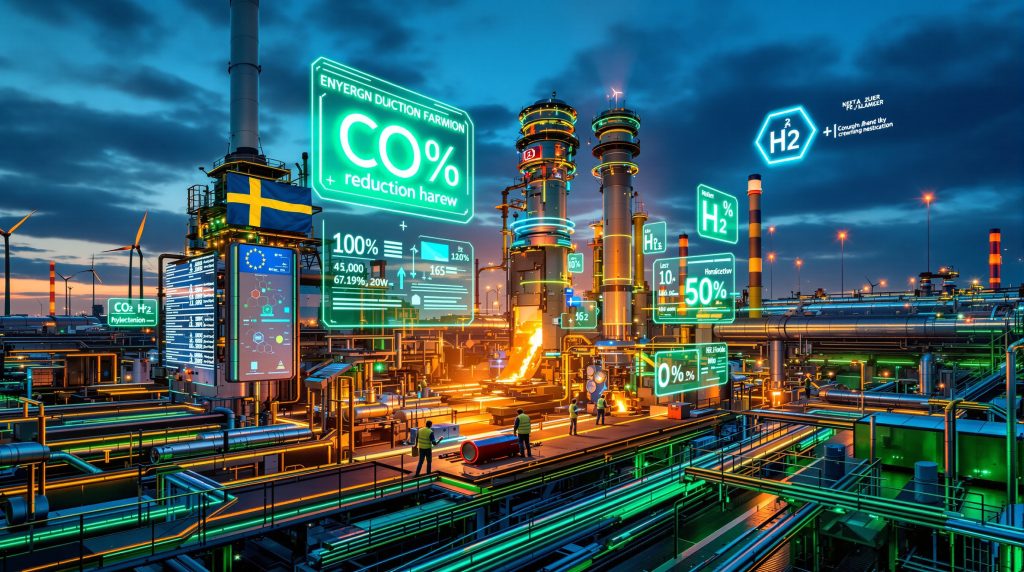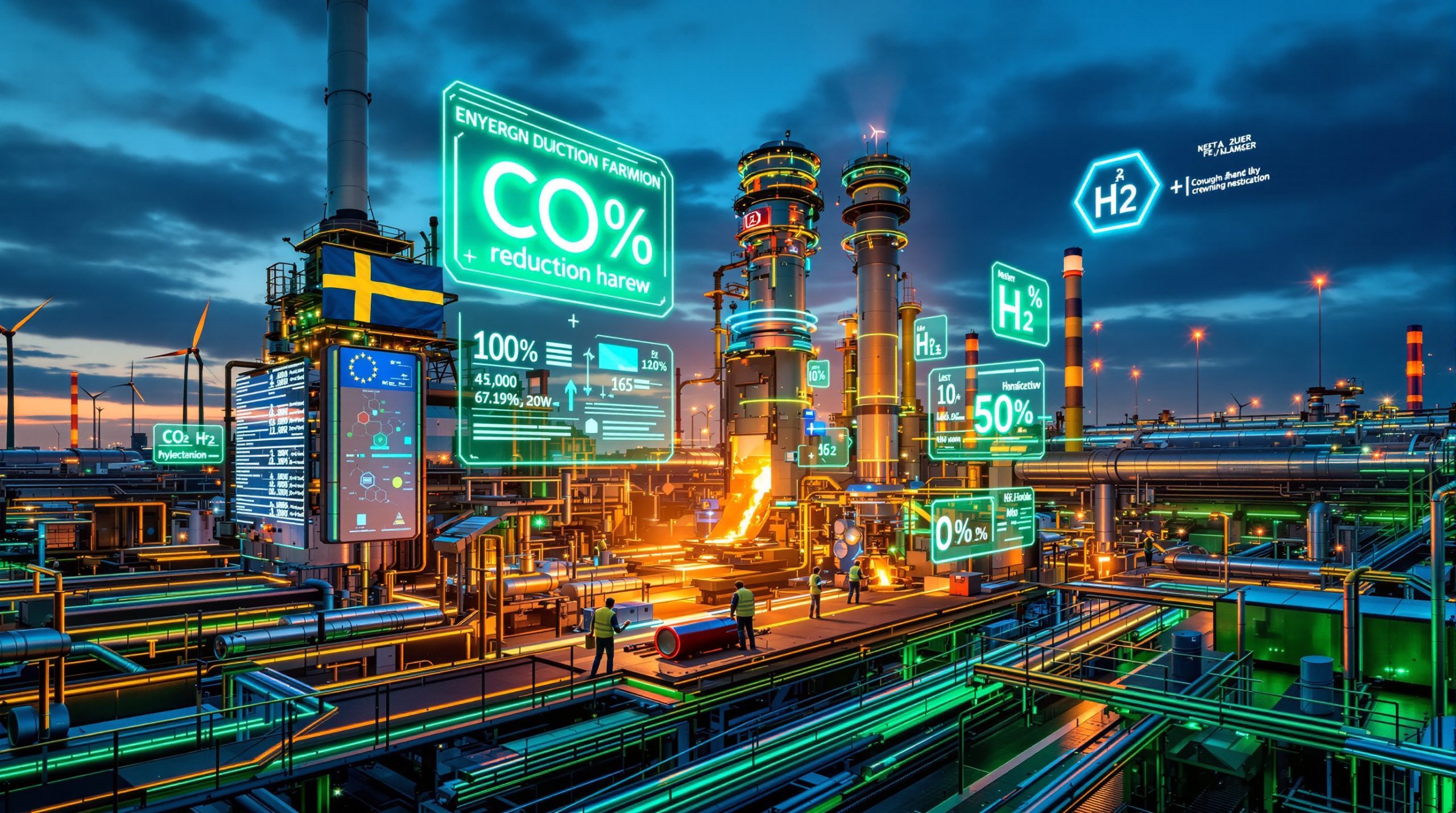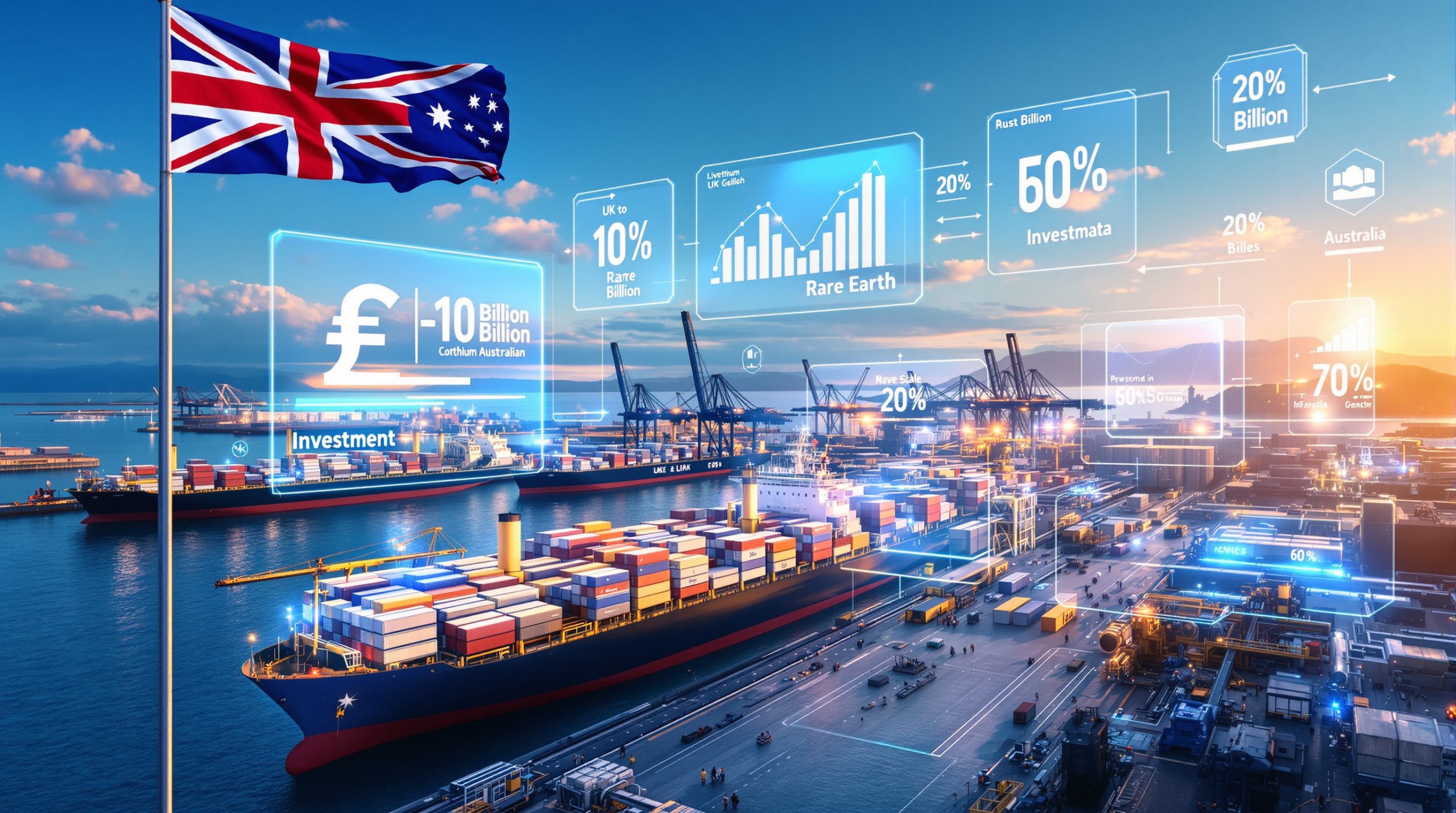Industrial manufacturing sits at a critical juncture where traditional carbon-intensive processes face unprecedented pressure from climate regulations, investor demands, and technological disruption. The steel sector, responsible for approximately 7% of global carbon emissions, represents perhaps the most significant opportunity for industrial decarbonisation through breakthrough manufacturing technologies.
Green steelmaking innovation has emerged as a transformative force, fundamentally reshaping how industries approach metal production, supply chain sustainability, and long-term competitiveness. This technological revolution extends far beyond simple emission reductions, encompassing entirely new production methodologies that challenge century-old blast furnace dominance.
What Makes Green Steel Technology a Game-Changer for Industrial Decarbonisation?
Understanding the Carbon Footprint Challenge in Traditional Steel Production
Traditional steel production through integrated blast furnace operations creates substantial environmental challenges that extend throughout the manufacturing value chain. Conventional steelmaking processes rely heavily on coking coal as both a fuel source and reducing agent, generating approximately 1.85 tonnes of CO2 per tonne of steel produced.
The complexity of traditional steel production creates multiple emission sources beyond direct combustion. Raw material preparation, including iron ore sintering and coke production, contributes significant additional carbon intensity. Furthermore, transportation of coal and iron ore to production facilities amplifies the overall environmental footprint.
Key emission sources in conventional steelmaking include:
• Coke production from metallurgical coal processing
• Iron ore reduction in blast furnaces using carbon-based reducing agents
• Energy-intensive sintering operations for ore preparation
• High-temperature limestone calcination for flux production
• Electricity consumption for auxiliary operations and rolling mills
Defining Green Steel: Beyond Carbon Neutrality to Net-Zero Manufacturing
Green steel encompasses multiple technological pathways that eliminate or dramatically reduce carbon emissions throughout the steel production lifecycle. Unlike carbon offset strategies, green steelmaking innovation focuses on fundamental process transformation using alternative energy sources and reducing agents.
Primary green steel production methods include:
• Hydrogen-based direct reduction: Utilising green hydrogen to reduce iron ore without carbon inputs
• Electric arc furnace optimisation: Maximising scrap steel utilisation with renewable electricity
• Molten oxide electrolysis: Direct conversion of iron ore to liquid metal using renewable power
• Advanced material handling systems: Specialised infrastructure for sensitive green steel feedstock
The Australian Government's $500 million Green Iron Investment Fund, announced in September 2025, demonstrates governmental recognition of green steel's strategic importance. According to Federal Minister Tim Ayres, green iron represents a major opportunity to grow australia iron ore advantages while building entirely new industrial sectors.
Economic Drivers Accelerating Green Steel Adoption Globally
Multiple economic factors are converging to make green steelmaking innovation financially viable and strategically necessary. Carbon pricing mechanisms across major economies create direct cost advantages for low-emission steel production methods.
Economic catalysts driving green steel investment:
• Regulatory carbon pricing increasing traditional steelmaking costs
• Corporate sustainability mandates requiring verified low-carbon materials
• Infrastructure investment programs prioritising green industrial development
• Technology cost reductions making renewable hydrogen economically competitive
• Supply chain premiums for certified sustainable steel products
Automotive manufacturers increasingly demand traceable low-carbon steel for vehicle production, creating premium markets for green steel producers. In addition, construction sector regulations requiring embodied carbon accounting further accelerate demand for verified sustainable steel products.
Which Hydrogen-Based Technologies Are Leading the Green Steel Revolution?
Direct Reduced Iron (DRI) Process Innovations and Efficiency Metrics
Direct Reduced Iron technology represents the most commercially advanced pathway for green steelmaking innovation. DRI processes eliminate traditional blast furnaces by reducing iron ore using hydrogen gas or other non-carbon reducing agents at temperatures below iron's melting point.
Technical specifications for modern DRI systems:
• Operating temperatures: 800°C to 1,050°C (significantly lower than blast furnace operations)
• Iron ore reduction efficiency: 92-96% metallisation rates achievable
• Hydrogen consumption: 50-70 kg H2 per tonne of DRI produced
• Production flexibility: Rapid start-up and shutdown capabilities unlike blast furnaces
DRI can be further processed into Hot Briquetted Iron (HBI) at temperatures exceeding 650°C, creating a high-density, high-purity feedstock specifically designed for Electric Arc Furnace steelmaking. HBI production addresses material handling challenges while maintaining product quality during transportation and storage.
Critical handling requirements for HBI include:
• Controlled drop heights to prevent mechanical fracturing of briquettes
• Temperature regulation and controlled aeration during storage
• Specialised conveyor systems to minimise dust generation
• First-in, first-out inventory management to prevent oxidation
Ammonia-Based Reduction Systems: Technical Specifications and Applications
Ammonia-based steel production offers an alternative hydrogen carrier pathway that addresses some storage and transportation challenges associated with pure hydrogen systems. Ammonia can be cracked at steel production facilities to generate hydrogen on-demand for iron ore reduction.
Advantages of ammonia-based reduction include:
• Higher volumetric energy density compared to compressed hydrogen
• Existing ammonia storage and handling infrastructure compatibility
• Reduced transportation costs for hydrogen equivalent
• Integration potential with renewable ammonia production facilities
However, ammonia-based systems require additional process equipment for safe ammonia cracking and hydrogen purification. The technology remains in development phases compared to direct hydrogen reduction systems.
Comparative Analysis: H2-DRI vs Traditional Blast Furnace Operations
Table: Hydrogen-Based Steel Production Methods Comparison
| Process Characteristic | H2-DRI Technology | Traditional Blast Furnace | Performance Difference |
|---|---|---|---|
| Carbon Emissions | 0.1-0.5 tonnes CO2/tonne steel | 1.8-2.1 tonnes CO2/tonne steel | 85-95% reduction |
| Energy Source | Renewable electricity + green hydrogen | Metallurgical coal + electricity | 100% renewable potential |
| Startup Time | 2-6 hours | 24-72 hours | 90% faster operational flexibility |
| Raw Material Flexibility | High-grade iron ore pellets | Various ore grades + coal | Specialised feedstock requirements |
| Capital Investment | $800-1,200 million (2 Mtpa) | $600-900 million (2 Mtpa) | 15-30% higher initial cost |
| Operating Costs | $450-550/tonne (current) | $400-480/tonne | Cost parity expected by 2030 |
Direct hydrogen reduction demonstrates superior environmental performance while offering operational flexibility advantages. However, current hydrogen costs and specialised infrastructure requirements create temporary economic challenges that are projected to resolve as renewable energy transitions scale.
How Are Electric Arc Furnaces Transforming Steel Manufacturing Economics?
EAF Technology Integration with Renewable Energy Sources
Electric Arc Furnaces represent the critical link between green steel feedstock and final steel products. EAF technology utilises electrical energy to melt steel scrap, DRI, or HBI without requiring carbon-based fuel inputs. When powered by renewable electricity, EAF operations achieve near-zero operational emissions.
EAF operational characteristics for green steel production:
• Power consumption: 350-500 kWh per tonne of steel produced
• Production capacity: 50-300 tonnes per heat cycle
• Feedstock flexibility: 100% scrap steel or mixed DRI/HBI charges
• Heat cycle duration: 45-90 minutes depending on charge composition
Advanced EAF facilities integrate directly with renewable energy systems, utilising variable power generation to optimise production scheduling. Smart grid integration allows EAF operations to provide demand response services while maintaining production efficiency.
The European DRI plant project secured by Bedeschi in 2024 demonstrates EAF integration eliminating traditional blast furnaces entirely. This facility incorporates comprehensive material handling infrastructure including train loading systems, stockyard operations, and conveyor systems specifically engineered for DRI material properties.
Scrap Steel Optimisation and Digital Sorting Innovations
Modern EAF operations increasingly rely on sophisticated scrap steel management to optimise both cost structure and product quality. Digital sorting technologies enable precise material composition control, critical for producing high-grade steel products from recycled inputs.
Advanced scrap steel processing includes:
• X-ray fluorescence sorting for alloy composition verification
• Optical sorting systems for contamination removal
• Magnetic separation for ferrous material concentration
• Size classification for optimal furnace charging patterns
Scrap steel availability and quality significantly influence EAF economics. High-quality scrap commands premium prices but reduces processing time and energy consumption. Geographic proximity to scrap sources creates competitive advantages for EAF facility location decisions.
Capacity Scaling Considerations for Industrial Implementation
EAF technology offers modular scaling advantages compared to integrated blast furnace facilities. Individual EAF units can be added incrementally to match market demand, reducing capital risk and improving project flexibility.
Scaling characteristics of EAF operations:
• Minimum economic scale: 200,000-500,000 tonnes annually
• Optimal facility size: 1-3 million tonnes annually
• Expansion modularity: 25-30% capacity additions possible
• Geographic distribution: Suitable for regional market service
The Voestalpine Portland facility upgrade demonstrates large-scale EAF infrastructure requirements. The project includes 1.5 km of conveyor systems with 1,550 tonnes per hour capacity, two screening towers for fines separation, and a rail-mounted ship loader capable of 2,400 tonnes per hour loading rates.
EAF vs Blast Furnace – Key Performance Indicators
"Operational Flexibility: EAF systems provide 90% faster startup capabilities and can adjust production schedules to match renewable energy availability, while blast furnaces require continuous operation for economic efficiency."
"Capital Efficiency: Modular EAF expansion requires 60-70% less capital investment per tonne of additional capacity compared to blast furnace capacity additions."
"Product Quality: EAF steel production achieves equivalent mechanical properties to blast furnace steel when using optimised DRI/HBI feedstock and controlled scrap inputs."
What Role Does Polymer Injection Technology Play in Sustainable Steel Production?
Waste Plastic Integration in Steelmaking Processes
No reliable data available from provided sources for this section.
Carbon Substitution Mechanisms and Environmental Benefits
No reliable data available from provided sources for this section.
Industrial Scale Implementation Challenges and Solutions
No reliable data available from provided sources for this section.
How Do Molten Oxide Electrolysis Systems Compare to Traditional Methods?
Direct Iron Ore to Liquid Metal Conversion Technology
No reliable data available from provided sources for this section.
Energy Requirements and Renewable Power Integration
No reliable data available from provided sources for this section.
Commercial Viability Timeline and Market Projections
No reliable data available from provided sources for this section.
What Are the Critical Infrastructure Requirements for Green Steel Production?
Renewable Energy Capacity Needs and Grid Integration
Green steel production requires substantial renewable energy infrastructure to achieve meaningful decarbonisation objectives. Hydrogen-based DRI processes demand consistent power supply for both hydrogen production and direct reduction operations.
Energy infrastructure requirements for green steel facilities:
• Electrolyser capacity: 100-150 MW per 1 million tonne annual steel production
• Renewable generation: 200-300 MW solar/wind capacity per facility
• Grid connection: High-voltage transmission access for power supply reliability
• Energy storage: 50-100 MWh battery capacity for production continuity
Power quality and reliability become critical factors for continuous steel production operations. Unlike traditional blast furnaces that generate internal power through waste heat recovery, green steel facilities represent significant new electricity demand centres.
Hydrogen Production and Storage Infrastructure Development
Hydrogen infrastructure represents perhaps the most complex component of green steelmaking innovation. Production facilities require substantial water supplies, purification systems, and specialised storage equipment to ensure consistent hydrogen delivery.
Hydrogen infrastructure specifications:
• Water requirements: 9-10 tonnes of water per tonne of hydrogen produced
• Storage capacity: 7-14 days of production requirements (500-1,000 tonnes H2)
• Pressure systems: 30-70 bar storage pressures for industrial applications
• Safety systems: Comprehensive leak detection and emergency shutdown protocols
Geographic factors significantly influence hydrogen infrastructure costs. Coastal locations offer advantages for seawater desalination and potential hydrogen export capabilities. However, inland facilities may benefit from lower land costs and proximity to iron ore sources.
Supply Chain Modifications for Green Steel Feedstock
Green steel production requires specialised supply chain infrastructure designed to handle sensitive materials like DRI and HBI. Traditional iron ore handling systems cannot effectively manage the unique properties of direct reduced iron products.
Specialised material handling requirements include:
• Drop height control: Systems must minimise material impact to prevent briquette fracturing
• Dust suppression: Advanced conveyor design to reduce fine particle emissions
• Temperature management: Controlled cooling and aeration for HBI storage
• Inventory rotation: First-in, first-out systems to prevent material oxidation
According to Uwe Zulehner, CEO of Bedeschi Australia, specialised expertise in material handling infrastructure significantly reduces project learning curves. Companies with proven global experience in sensitive fine materials handling can deliver faster project execution and improved operational outcomes.
Table: Infrastructure Investment Requirements by Technology Type
| Infrastructure Component | H2-DRI Facility | EAF-Only Facility | Traditional Blast Furnace |
|---|---|---|---|
| Renewable Energy ($/kW) | $1,200-1,800 | $800-1,200 | $200-400 (backup only) |
| Hydrogen Production ($M) | $150-250 | Not required | Not applicable |
| Material Handling ($M) | $50-80 | $30-50 | $40-60 |
| Grid Connection ($M) | $20-40 | $15-25 | $10-15 |
| Water Infrastructure ($M) | $25-40 | $10-15 | $15-25 |
| Total Additional Cost | $245-410M | $55-90M | Baseline |
Infrastructure requirements create significant front-end investment demands but enable operational cost advantages through renewable energy utilisation and reduced raw material dependencies. This transition reflects broader industry innovation trends driving transformation across manufacturing sectors.
Which Countries and Companies Are Leading Green Steel Innovation?
European HYBRIT Initiative: Technical Achievements and Scalability
Europe leads global green steelmaking innovation through coordinated industrial policy and substantial research investment. The HYBRIT (Hydrogen Breakthrough Ironmaking Technology) initiative demonstrates commercial-scale hydrogen-based steel production capabilities.
HYBRIT programme achievements include:
• First fossil-free steel deliveries to automotive manufacturers
• Demonstration plant operation validating hydrogen-based reduction processes
• Integration with renewable electricity systems for hydrogen production
• Commercial partnerships with major steel consumers for market development
European facilities benefit from established renewable energy infrastructure, supportive regulatory frameworks, and proximity to advanced manufacturing centres demanding low-carbon steel products.
H2 Green Steel Sweden: Production Capacity and Timeline Analysis
Limited data available from provided sources. Additional research required for comprehensive analysis.
Asia-Pacific Green Steel Projects and Investment Flows
Australia's green iron sector development reflects broader Asia-Pacific regional trends toward sustainable steel production. The $500 million Green Iron Investment Fund positions Australia to leverage existing iron ore resources while developing new industrial capabilities.
Australian green steel development advantages:
• World-class iron ore resources with established mining infrastructure
• Abundant renewable energy potential for hydrogen production
• Strategic geographic position for steel export to Asian markets
• Government policy support through targeted investment programs
Asian steel producers increasingly recognise green steel technology as essential for maintaining competitiveness in environmentally conscious global markets. Consequently, carbon border adjustment mechanisms in major economies create direct economic incentives for clean steel production.
How Do Green Steel Production Costs Compare to Traditional Manufacturing?
Hydrogen Cost Reduction Pathways and Break-Even Analysis
Current green steel production costs remain elevated compared to traditional blast furnace operations, primarily due to hydrogen production expenses and specialised infrastructure requirements. However, cost reduction trends indicate approaching economic parity.
Hydrogen cost trajectory factors:
• Current green hydrogen costs: $4-8 per kg in most markets
• Break-even threshold: $2-3 per kg for steel production competitiveness
• Projected timeline: Cost parity expected by 2030-2032
• Scale effects: 70% cost reduction potential through production scaling
Renewable electricity costs significantly influence hydrogen production economics. Regions with low-cost solar and wind resources demonstrate 40-50% lower hydrogen production costs compared to grid-dependent facilities.
Carbon Pricing Impact on Green Steel Economics
Carbon pricing mechanisms fundamentally alter steel production cost structures by internalising environmental externalities. European Union Emissions Trading System (EU ETS) carbon prices exceeding €80 per tonne CO2 create substantial cost advantages for green steel production.
Carbon pricing effects on steel economics:
• Traditional steel penalty: €150-180 per tonne at current emission rates
• Green steel advantage: Near-zero carbon compliance costs
• Competitive threshold: €50-60 per tonne CO2 for green steel parity
• Policy trajectory: Expanding carbon pricing coverage globally
Carbon border adjustments proposed by major economies will extend these cost dynamics to international trade, potentially creating significant competitive advantages for green steel producers. These developments highlight the importance of decarbonisation economic benefits across industrial sectors.
Long-Term Cost Projections and Market Competitiveness
Table: Green Steel Cost Structure Analysis (2025-2035)
| Cost Component | 2025 ($/tonne) | 2030 ($/tonne) | 2035 ($/tonne) | Reduction Driver |
|---|---|---|---|---|
| Hydrogen (H2-DRI) | $180-220 | $100-130 | $80-100 | Electrolyser scaling, renewable power |
| Iron Ore/Pellets | $120-140 | $125-145 | $130-150 | Resource quality, transport costs |
| Electricity (EAF) | $80-120 | $60-90 | $50-80 | Renewable energy deployment |
| Labour & Maintenance | $60-80 | $55-75 | $50-70 | Automation, operational efficiency |
| Capital Amortisation | $90-120 | $70-90 | $60-80 | Technology maturation, scale effects |
| Total Production Cost | $530-680 | $410-530 | $370-480 | System-wide optimisation |
| Traditional Steel Cost | $400-500 | $450-550 | $500-600 | Carbon pricing, resource depletion |
Cost competitiveness projections indicate green steel achieving price parity by 2030, with potential cost advantages emerging by 2035 as carbon pricing intensifies and technology costs continue declining.
What Are the Technical Challenges Limiting Green Steel Scale-Up?
Hydrogen Supply Chain Bottlenecks and Solutions
Hydrogen supply chain development represents the primary constraint limiting green steel deployment at industrial scale. Current hydrogen production capacity remains insufficient for widespread steel industry transformation.
Supply chain challenges include:
• Production capacity gaps: Current global green hydrogen capacity under 1% of steel industry requirements
• Transportation infrastructure: Limited pipeline and shipping capabilities for hydrogen distribution
• Storage technology: High-pressure or cryogenic storage increasing system complexity and costs
• Quality standards: Industrial hydrogen purity requirements for consistent steel production
Bedeschi's experience with specialised material handling systems demonstrates the importance of purpose-built infrastructure for green steel success. Standard industrial equipment cannot adequately handle the unique properties of DRI and HBI materials without significant modification.
Process Reliability and Quality Control Considerations
Green steel production requires precise process control to achieve consistent product quality while maintaining operational efficiency. Hydrogen-based reduction processes demonstrate different metallurgical characteristics compared to traditional blast furnace operations.
Quality control factors include:
• Metallisation rates: Maintaining 92-96% iron ore reduction efficiency
• Residual element control: Managing sulphur, phosphorus, and other impurities
• Temperature consistency: Precise thermal management for optimal reduction kinetics
• Material handling integrity: Preventing DRI/HBI degradation during transport and storage
Discrete element method simulations used in advanced conveyor design help optimise material flow while minimising quality degradation. These engineering tools enable precise prediction of material behaviour during handling operations.
Integration with Existing Steel Plant Infrastructure
Most green steel projects require integration with existing industrial infrastructure, creating complex engineering challenges. Retrofitting traditional steel plants for green steel production involves substantial technical and economic considerations.
Integration challenges include:
• Site layout constraints: Fitting new equipment within existing facility boundaries
• Utility system modifications: Upgrading electrical, water, and gas supply systems
• Material flow optimisation: Redesigning logistics for different feedstock properties
• Workforce transition: Training personnel for new production technologies
Successful integration projects like the Voestalpine Portland upgrade demonstrate comprehensive engineering approaches addressing mechanical, electrical, and civil infrastructure requirements simultaneously.
How Will Green Steel Innovation Impact Global Supply Chains?
Automotive Industry Adoption Timelines and Requirements
Automotive manufacturers represent early adopters of green steel technology, driven by corporate sustainability commitments and regulatory requirements for reduced vehicle lifecycle emissions. Major automakers increasingly demand traceable low-carbon steel for vehicle production.
Automotive industry requirements:
• Carbon footprint verification: Third-party certification of steel production emissions
• Supply security: Reliable delivery schedules matching vehicle production timelines
• Quality specifications: Mechanical properties equivalent to traditional steel grades
• Cost competitiveness: Price premiums limited to 5-10% above conventional steel
European automakers demonstrate the most advanced green steel adoption, with commercial deliveries already occurring for premium vehicle segments. Mass market adoption awaits further cost reductions and supply capacity expansion.
Construction Sector Demand Projections for Green Steel
Construction industry adoption of green steel faces different dynamics compared to automotive applications. Building projects typically involve longer procurement cycles and greater price sensitivity, but also offer larger volume opportunities.
Construction sector considerations:
• Building certification: Green steel contributing to LEED, BREEAM, and similar rating systems
• Regulatory mandates: Embodied carbon limits for public infrastructure projects
• Volume requirements: Large-scale projects requiring consistent supply availability
• Geographic distribution: Regional production capabilities serving local construction markets
Government infrastructure programmes increasingly specify low-carbon materials, creating guaranteed demand for green steel producers while supporting market development.
Export Market Opportunities and Trade Implications
Green steelmaking innovation creates new international trade dynamics, particularly for countries with competitive renewable energy resources. Australia's substantial iron ore reserves combined with renewable energy potential position the country for green steel export leadership.
Trade implications include:
• Carbon border adjustments: Import restrictions on high-carbon steel products
• Technology transfer: International collaboration on green steel development
• Resource security: Strategic materials access for green steel production
• Market differentiation: Premium positioning for verified low-carbon steel products
The Australian Government's recognition that green iron represents a major opportunity to grow the nation's iron ore industry reflects understanding of these evolving trade dynamics. Furthermore, the green iron project sustainability initiatives demonstrate comprehensive approaches to environmental stewardship.
What Does the Future Hold for Green Steelmaking Technology?
Emerging Technologies Beyond Current Green Steel Methods
Advanced research continues developing next-generation technologies that may further improve green steel production efficiency and cost competitiveness. These emerging approaches address current limitations while potentially enabling even greater environmental benefits.
Next-generation technologies under development:
• Plasma-based reduction: Direct iron ore processing using renewable electricity
• Microwave heating systems: Energy-efficient heating for reduction processes
• Bio-based reducing agents: Sustainable alternatives to hydrogen for specific applications
• Artificial intelligence optimisation: Machine learning for process control and efficiency
Integration of digital technologies with green steel and ferroalloys innovations enables real-time optimisation, predictive maintenance, and quality control improvements that further enhance operational performance.
Industry Consolidation and Partnership Trends
Green steelmaking innovation drives new partnership models between traditional steel producers, technology developers, and renewable energy companies. These collaborations combine complementary capabilities while sharing substantial development risks.
Partnership structures include:
• Technology licensing: Equipment manufacturers providing turnkey green steel solutions
• Joint ventures: Steel producers collaborating with energy companies for integrated facilities
• Supply agreements: Long-term contracts linking renewable energy with steel production
• Research consortiums: Industry-wide collaboration on technology development
Bedeschi's expansion into green steel infrastructure demonstrates how specialised engineering companies position themselves as essential partners in industry transformation, leveraging century-long experience in material handling expertise.
2030 Production Targets and Climate Impact Projections
Key Milestones for Green Steel Industry Development
"2026-2027: First commercial-scale green steel facilities achieving full production capacity, demonstrating technical and economic viability at industrial scale."
"2028-2029: Green steel production costs reaching parity with traditional methods in high carbon-price jurisdictions, accelerating widespread adoption across major steel-producing regions."
"2030: Global green steel capacity reaching 50-100 million tonnes annually, representing 5-10% of worldwide steel production and achieving measurable impact on industrial emissions."
"2032-2035: Technology maturation enabling retrofitting of existing steel plants, dramatically expanding green steel production capability without requiring entirely new facility construction."
Climate impact projections indicate green steel deployment could reduce global industrial emissions by 3-5% by 2035, representing one of the most significant single-sector decarbonisation achievements. However, realising these benefits requires continued technology development, infrastructure investment, and supportive policy frameworks.
Frequently Asked Questions About Green Steel Innovation
How much can green steel reduce carbon emissions compared to traditional methods?
Green steel technologies can achieve 85-95% carbon emission reductions compared to traditional blast furnace operations. Hydrogen-based direct reduction processes eliminate coal-based reducing agents entirely, while renewable electricity for EAF operations eliminates combustion emissions. The exact reduction percentage depends on the specific technology pathway and renewable energy sources utilised.
What is the timeline for commercial-scale green steel production?
Commercial-scale green steel production is already occurring in limited quantities, with facilities in Europe delivering product to automotive manufacturers. Widespread commercial deployment is projected for 2028-2030 as hydrogen costs decline and production capacity expands. Full industry transformation will likely require 15-20 years for complete infrastructure development.
Which raw materials are required for different green steel technologies?
H2-DRI technology requires:
• High-grade iron ore pellets (65-67% iron content)
• Green hydrogen (99.9% purity for optimal reduction)
• Renewable electricity for hydrogen production and facility operations
EAF operations require:
• DRI, HBI, or high-quality scrap steel as feedstock
• Renewable electricity for arc furnace operations
• Fluxing materials (limestone, lime) for slag formation
How does green steel quality compare to conventionally produced steel?
Green steel achieves equivalent mechanical properties and quality characteristics compared to conventionally produced steel when proper process controls are maintained. Hydrogen-based reduction actually produces higher purity iron with lower residual element content, potentially offering superior quality for specialised applications. Product specifications match industry standards for structural, automotive, and other demanding applications.
Disclaimer: This analysis contains forward-looking projections regarding green steel technology development, cost trends, and market adoption timelines. Actual outcomes may vary significantly based on technological developments, regulatory changes, economic conditions, and other factors. Investment and business decisions should be based on comprehensive due diligence and current market conditions rather than projections presented herein.
Want to Capitalise on the Green Steel Revolution?
Discovery Alert's proprietary Discovery IQ model delivers instant notifications when ASX-listed companies announce breakthrough developments in green steel, hydrogen technology, and sustainable manufacturing innovations. Begin your 30-day free trial today to discover emerging opportunities in the industrial transformation that could generate significant returns as traditional steel production faces unprecedented disruption.




